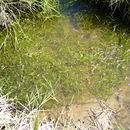en
names in breadcrumbs


Najas guadalupensis is a species of aquatic plant known by the common names southern waternymph,[3] guppy grass, najas grass, and common water nymph. It is native to the Americas, where it is widespread. It is considered native to Canada (from Alberta to Quebec), and most of the contiguous United States, Mexico, Central America, the West Indies and South America. It has been introduced in Japan, Israel and Palestine.[4]
Najas guadalupensis is an annual, growing submerged in aquatic habitat types such as ponds, ditches, and streams. It produces a slender, branching stem up to 60 to 90 centimeters in maximum length. The thin, somewhat transparent, flexible leaves are up to 3 centimeters long and just 1 or 2 millimeters wide. They are edged with minute, unicellular teeth. Tiny flowers occur in the leaf axils; staminate flowers grow toward the end of the plant and pistillate closer to the base.[5][6][7] They are also a popular aquarium plant for beginners due to their hardiness as well as growth rate, which helps provide shelter for aquarium fish.[8][9]
Numerous varietal and subspecific names have been proposed. Only four are currently recognized:[2][10]
{{cite journal}}: Cite journal requires |journal= (help) Najas guadalupensis is a species of aquatic plant known by the common names southern waternymph, guppy grass, najas grass, and common water nymph. It is native to the Americas, where it is widespread. It is considered native to Canada (from Alberta to Quebec), and most of the contiguous United States, Mexico, Central America, the West Indies and South America. It has been introduced in Japan, Israel and Palestine.
Najas guadalupensis is an annual, growing submerged in aquatic habitat types such as ponds, ditches, and streams. It produces a slender, branching stem up to 60 to 90 centimeters in maximum length. The thin, somewhat transparent, flexible leaves are up to 3 centimeters long and just 1 or 2 millimeters wide. They are edged with minute, unicellular teeth. Tiny flowers occur in the leaf axils; staminate flowers grow toward the end of the plant and pistillate closer to the base. They are also a popular aquarium plant for beginners due to their hardiness as well as growth rate, which helps provide shelter for aquarium fish.
Najas guadalupensis,[1] i svensk handel kallad guppygräs,[2] är en art av najasar bland dybladsväxterna. Arten blev först vetenskapligt beskriven år 1824 av den tyske botanikern Kurt Sprengel, och fick år 1870 sitt nu gällande vetenskapliga namn av Paul Wilhelm Magnus, även han tysk botaniker.[3][4][5] Vid goda ljusförhållanden kan den vara mycket snabbväxande, och förekommer bland annat därför relativt ofta inom akvaristiken.
Arten delas in i följande underarter:[3]
Underarter Auktorsnamn N. g. subsp. floridana R.R.Haynes & W.A.Wentz N. g. subsp. guadalupensis (Spreng.) Magnus N. g. subsp. muenscheri (R.T.Clausen) R.R.Haynes & Hellq. N. g. subsp. olivacea (Rosendahl & Butters) R.R.Haynes & Hellq.Najas guadalupensis, i svensk handel kallad guppygräs, är en art av najasar bland dybladsväxterna. Arten blev först vetenskapligt beskriven år 1824 av den tyske botanikern Kurt Sprengel, och fick år 1870 sitt nu gällande vetenskapliga namn av Paul Wilhelm Magnus, även han tysk botaniker. Vid goda ljusförhållanden kan den vara mycket snabbväxande, och förekommer bland annat därför relativt ofta inom akvaristiken.
Najas guadalupensis là một loài thực vật có hoa trong họ Hydrocharitaceae. Loài này được (Spreng.) Magnus mô tả khoa học đầu tiên năm 1870.[1]
Najas guadalupensis là một loài thực vật có hoa trong họ Hydrocharitaceae. Loài này được (Spreng.) Magnus mô tả khoa học đầu tiên năm 1870.